-

Case Interview Course (Most Popular)
CourseBecome a top 10% case interview candidate in 7 days while saving 100+ hours.
$299 / year
-

Consulting Behavioral & Fit Interview Course
CourseMaster 98% of consulting fit interview questions in a few hours.
$99
-

Consulting Resume Review & Editing Service
CourseCraft the perfect consulting resume with unlimited revisions and 24-hour turnaround.
$399
Issue Trees: Step-By-Step Guide with Examples (2025)

An issue tree is a structured framework used to break down and analyze complex problems or questions into smaller components. It is a visual representation of the various aspects, sub-issues, and potential solutions related to a particular problem.
Issue trees are commonly used in business, consulting, problem-solving, and decision-making processes.
If you’re looking to better understand issue trees and how to use them in consulting case interviews or in business, we have you covered.
In this comprehensive article, we’ll cover:
- What is an issue tree?
- Why are issue trees important?
- How do I create an issue tree?
- How do I use issue trees in consulting case interviews?
- What are examples of issue trees?
- What are tips for making effective issue trees?
If you’re looking for a step-by-step shortcut to learn case interviews quickly, enroll in our case interview course. These insider strategies from a former Bain interviewer helped 30,000+ land consulting offers while saving hundreds of hours of prep time.
What is an Issue Tree?
An issue tree is a visual representation of a complex problem or question broken down into smaller, more manageable components. It consists of a top level issue, visualized as the root question, and sub-issues, visualized as branches and sub-branches.
- Top Level Issue (Root Question): This is the main problem or question that needs to be addressed. It forms the root of the tree.
- Sub-issues (Branches): Underneath the top level issue are branches representing the major categories or dimensions of the problem. These are the high-level areas that contribute to the overall problem.
- Further Sub-issues (Sub-branches): Each branch can be broken down further into more specific sub-issues.
Issue trees generally take on the following structure.
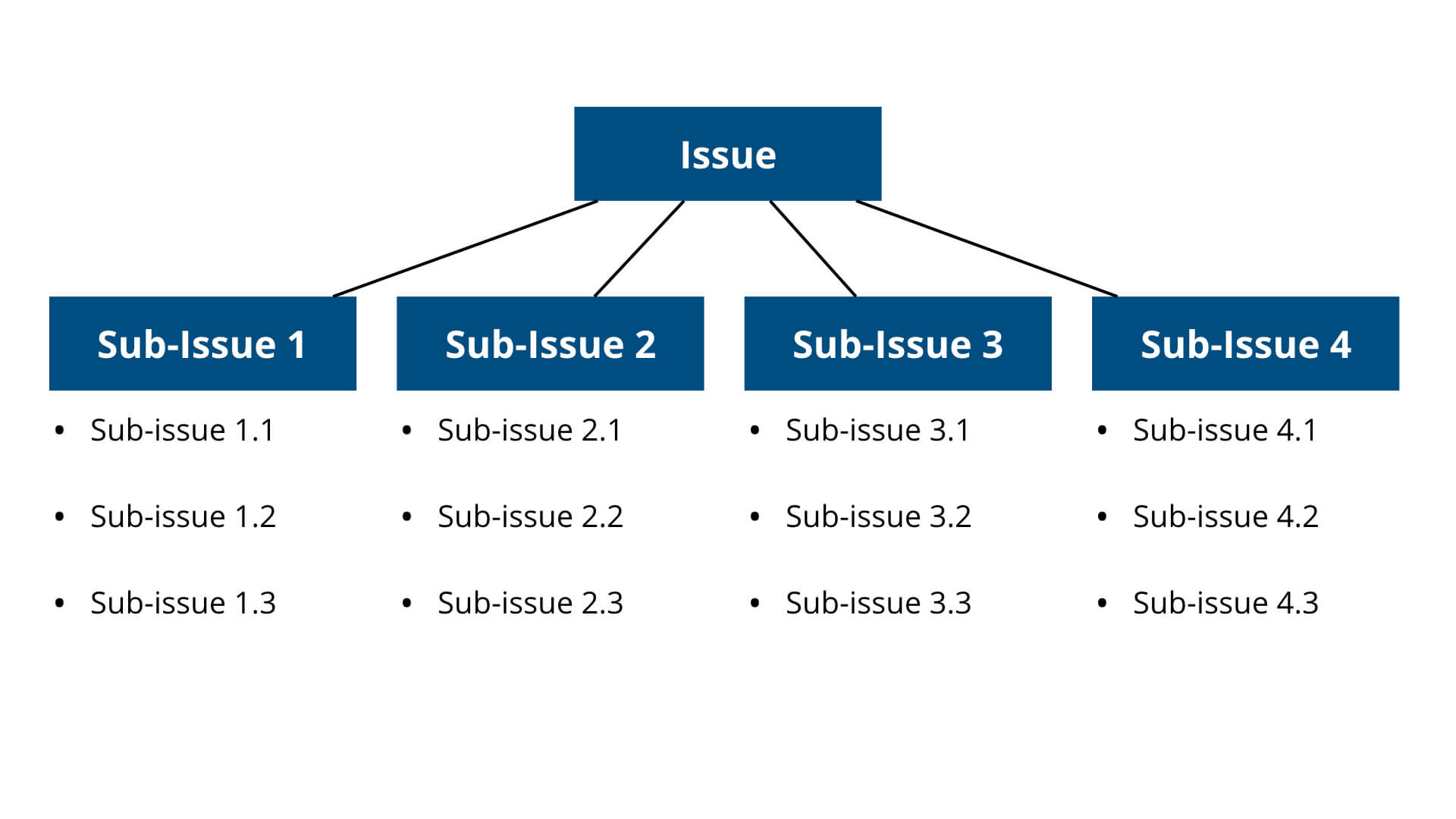
Issue trees get their name because the primary issue that you are solving for can be broken down into smaller issues or branches. These issues can then be further broken down into even smaller issues or branches.
This can be continued until you are left with a long list of small issues that are much simpler and more manageable. No matter how complicated or difficult a problem is, an issue tree can provide a way to structure the problem to make it easier to solve.
As an example, let’s say that we are trying to help a lemonade stand increase their profits. The overall problem is determining how to increase profits.
Since profits is equal to revenue minus costs, we can break this problem down into two smaller problems:
- How can we increase revenues?
- How can we decrease costs?
Since revenue is equal to quantity times price, we can further break this revenue problem down into two even smaller problems:
- How can we increase quantity sold?
- How can we increase price?
Looking at the problem of how to increase quantity sold, we can further break that problem down:
- How can we increase the quantity of lemonade sold?
- How can we increase the quantity of other goods sold?
We can repeat the same procedure for the costs problem since we know that costs equal variable costs plus fixed costs.
- How can we decrease variable costs?
- How can we decrease fixed costs?
Looking at the problem of how to decrease variable costs, we can further break that down by the different variable cost components of lemonade:
- How can we decrease costs of lemons?
- How can we decrease costs of water?
- How can we decrease costs of ice?
- How can we decrease costs of sugar?
- How can we decrease costs of cups?
The overall issue tree for this example would look like the following:
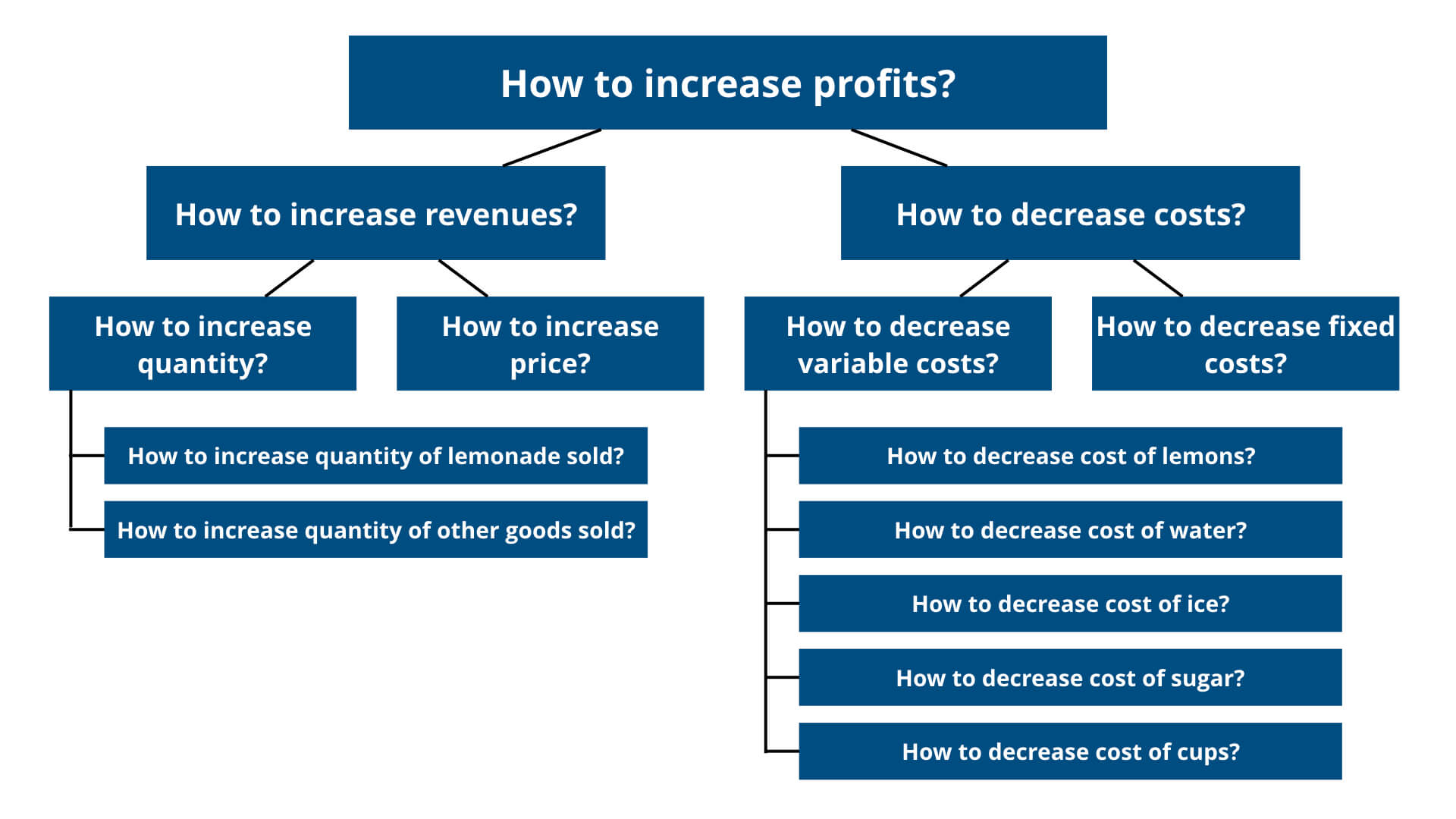
In this example, the issue tree is a special kind of issue tree known as a profit tree.
Why are Issue Trees Important?
Issue trees are helpful because they facilitate systematic analysis, managing complexity, prioritization, generating solutions, identifying root causes, work subdivision, roadmap generation, and effective communication.
Systematic analysis: Issue trees guide a systematic analysis of the problem. By dissecting the problem into its constituent parts, you can thoroughly examine each aspect and understand its implications.
Managing complexity: Complex problems often involve multiple interrelated factors. Issue trees provide a way to manage this complexity by organizing and visualizing the relationships between different components.
Prioritization: Issue trees help in prioritizing actions. By assessing the importance and impact of each sub-issue, you can determine which aspects of the problem require immediate attention.
Generating solutions: Issue trees facilitate the generation of potential solutions or strategies for each component of the problem. This allows for a more comprehensive approach to problem-solving.
Identifying root causes: Issue trees help in identifying the root causes of a problem. By drilling down through the sub-issues, you can uncover the underlying factors contributing to the main issue.
Work subdivision: Issue trees provide you with a list of smaller, distinct problems or areas to explore. This distinction makes it easy for you to divide up work.
Roadmap generation: Issue trees layout exactly all of the different areas or issues that you need to focus on in order to solve the overall problem. This gives you a clear idea of where to focus your attention and work on.
Effective communication: Issue trees are powerful communication tools. Visualizing the problem in a structured format helps in explaining it to others, including team members, stakeholders, or clients.
How Do I Create An Issue Tree?
Creating an issue tree involves several steps. Here's a step-by-step guide to help you through the process:
Step 1: Define the top-level issue
Start by clearly articulating the main problem or question that you want to address. This will form the root of your issue tree.
Step 2: Identify the branches (sub-issues)
Consider the major sub-issues that contribute to the overall problem. These will become the branches of your issue tree. Brainstorm and list them down.
There are four major ways that you can break down the root problem in an issue tree. You can break down the issue by stakeholder, process, segments, or math.
- Stakeholder: Break the problem down by identifying all stakeholders involved. This may include the company, customers, competitors, suppliers, manufacturers, distributors, and retailers. Each stakeholder becomes a branch for the top-level issue.
- Process: Break the problem down by identifying all of the different steps in the process. Each step becomes a branch for the top-level issue.
- Segment: Break the problem down into smaller segments. This may include breaking down the problem by geography, product, customer segment, market segment, distribution channel, or time horizon. Each segment becomes a branch for the top-level issue.
- Math: Break a problem down by quantifying the problem into an equation or formula. Each term in the equation is a branch for the top-level issue.
Step 3: Break down each branch
For each branch, ask yourself if there are further components that contribute to it. If so, break down each branch into more specific components. Continue this process until you've reached a level of detail that allows for meaningful analysis.
Similar to the previous step, you can break down a branch by stakeholder, process, segment, or by math.
Step 4: Review and refine
Take a step back and review your issue tree. Make sure it accurately represents the problem and its components. Look for any missing or redundant branches or sub-issues.
Step 5: Prioritize and evaluate
Consider assigning priorities to different sub-issues or potential solutions. This will help guide your decision-making process.
How Do I Use Issue Trees in Consulting Case Interviews?
Issue trees are used near the beginning of the consulting case interview to break down the business problem into smaller, more manageable components.
After the interviewer provides the case background information, you’ll be expected to quickly summarize the context of the case and verify the case objective. After asking clarifying questions, you’ll ask for a few minutes of silence to create an issue tree.
After you have created an issue tree, here’s how you would use it:
Step 1: Walk your interviewer through the issue tree
Once you’ve created an issue tree, provide a concise summary of how it's structured and how it addresses the problem at hand. Explain the different branches and sub-branches. They may ask a few follow-up questions.
As you are presenting your issue tree, periodically check in with the interviewer to ensure you're on the right track. Your interviewer may provide some input or guidance on improving your issue tree.
Step 2: Identify an area of your issue tree to start investigating
Afterwards, you’ll use the issue tree to help identify a branch to start investigating. There is generally no wrong answer here as long as you have a reason that supports why you want to start with a particular branch.
To determine which branch to start investigating, ask yourself a few questions. What is the most important sub-issue? Consider factors like urgency, impact, or feasibility. What is your best guess for how the business problem can be solved?
Step 3: Gather data and information
Collect relevant facts, data, and information for the sub-issue that you are investigating. This will provide the necessary context and evidence for your analysis.
Step 4: Record key insights on the issue tree
After diving deeper into each sub-issue or branch on your issue tree, you may find it helpful to write a few bullets on the key takeaways or insights that you’ve gathered through your analysis.
This will help you remember all the work that you have done during the case interview so far. It’ll also help you develop a recommendation at the end of the case interview because you’ll quickly be able to read a summary of all of your analysis.
Step 5: Iterate and adjust as needed
As you work through the problem-solving process, be prepared to adjust and update the issue tree based on new information, insights, or changes in the situation.
Remember, creating an issue tree is not a one-size-fits-all process. It's a dynamic tool that can be adapted to suit the specific needs and complexity of the problem you're addressing.
Step 6: Select the next area of your issue tree to investigate
Once you have finished analyzing a branch or sub-issue on your issue tree and reached a satisfactory insight or conclusion, move onto the next branch or sub-issue.
Again, consider factors like urgency, impact, or feasibility when prioritizing which branch or sub-issue to dive deeper into. Repeat this step until the end of the case interview when you are asked for a final recommendation.
What are Examples of Issue Trees?
Below are five issue tree examples for five common types of business situations and case interviews.
If you want to learn strategies on how to create unique and tailored issue trees for any case interview, check out our comprehensive article on case interview frameworks.
Profitability Issue Tree Example
Profitability cases ask you to identify what is causing a company’s decline in profits and what can be done to address this problem.
A potential issue tree template for this case could explore four major issues:
- What is causing the decline in profitability?
- Is the decline due to changes among customers?
- Is the decline due to changes among competitors?
- Is the decline due to market trends?
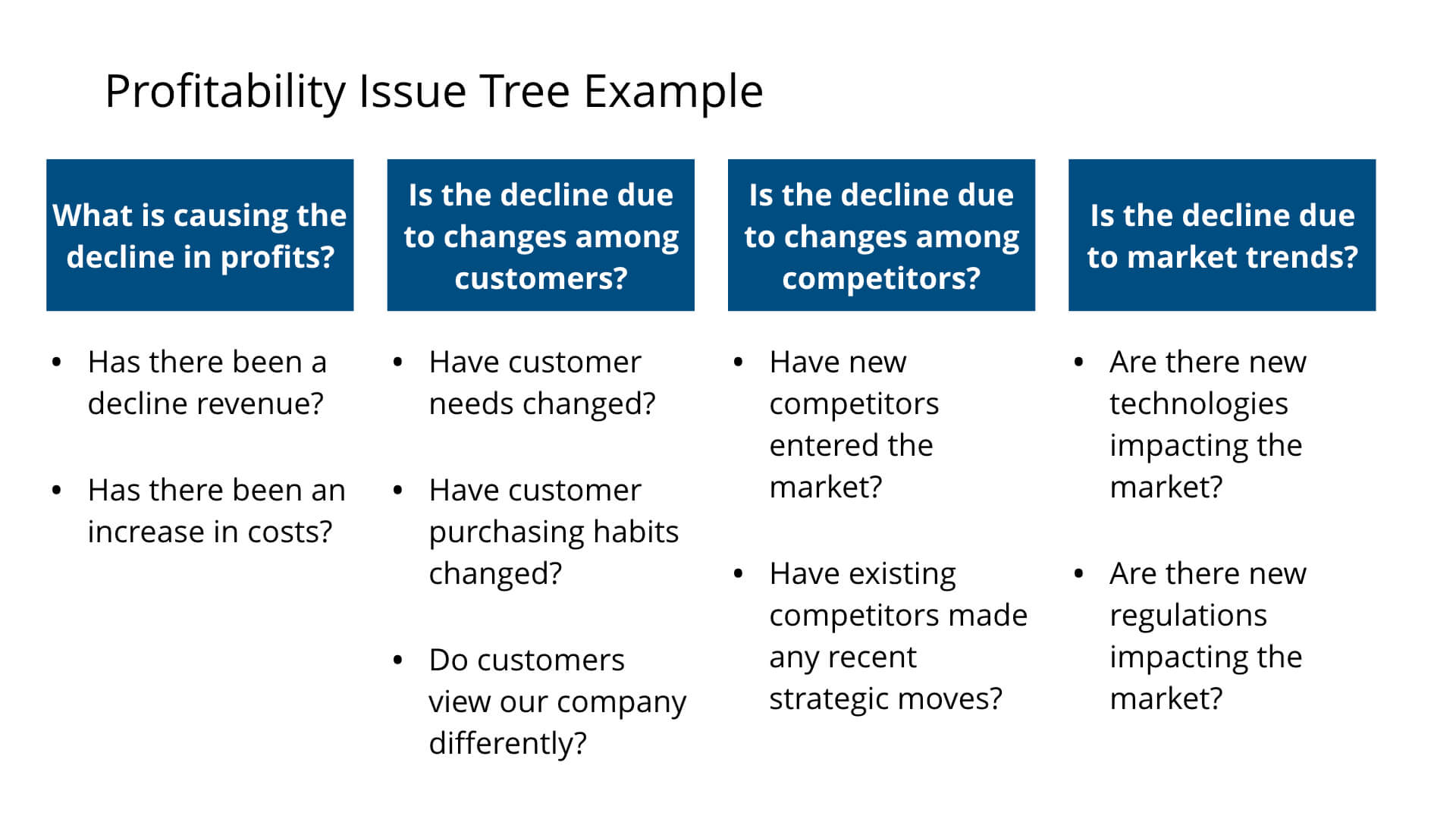
Market Entry Issue Tree Example
Market entry cases ask you to determine whether a company should enter a new market.
A potential issue tree template for this case could explore four major issues:
- Is the market attractive?
- Are competitors strong?
- Does the company have the capabilities to enter?
- Will the company be profitable from entering the market?
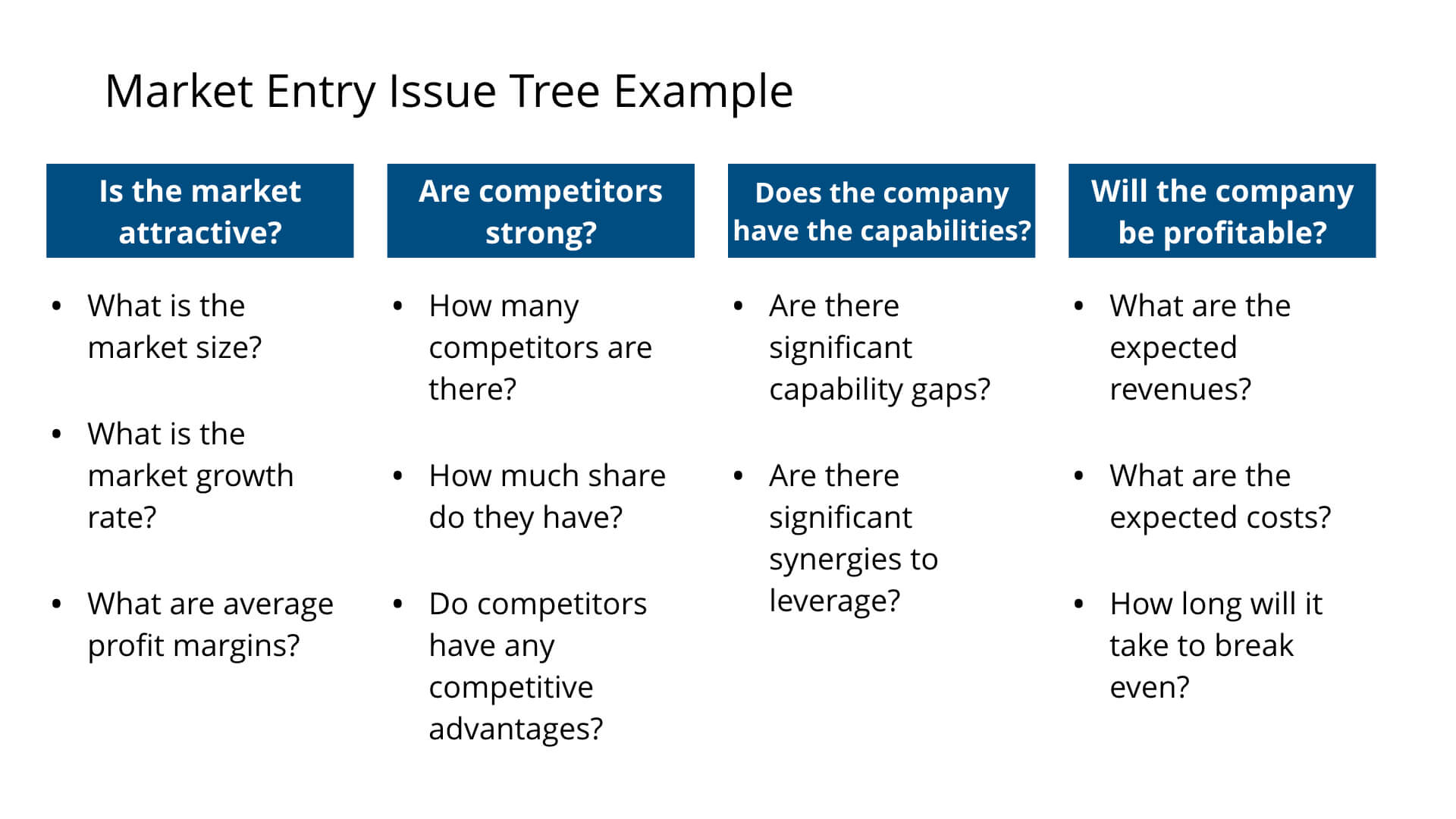
Merger and Acquisition Issue Tree Example
Merger and acquisition cases ask you to determine whether a company or private equity firm should acquire a particular company.
A potential issue tree template for this case could explore four major issues:
- Is the market that the target is in attractive?
- Is the acquisition target an attractive company?
- Are there any acquisition synergies?
- Will the acquisition lead to high returns?
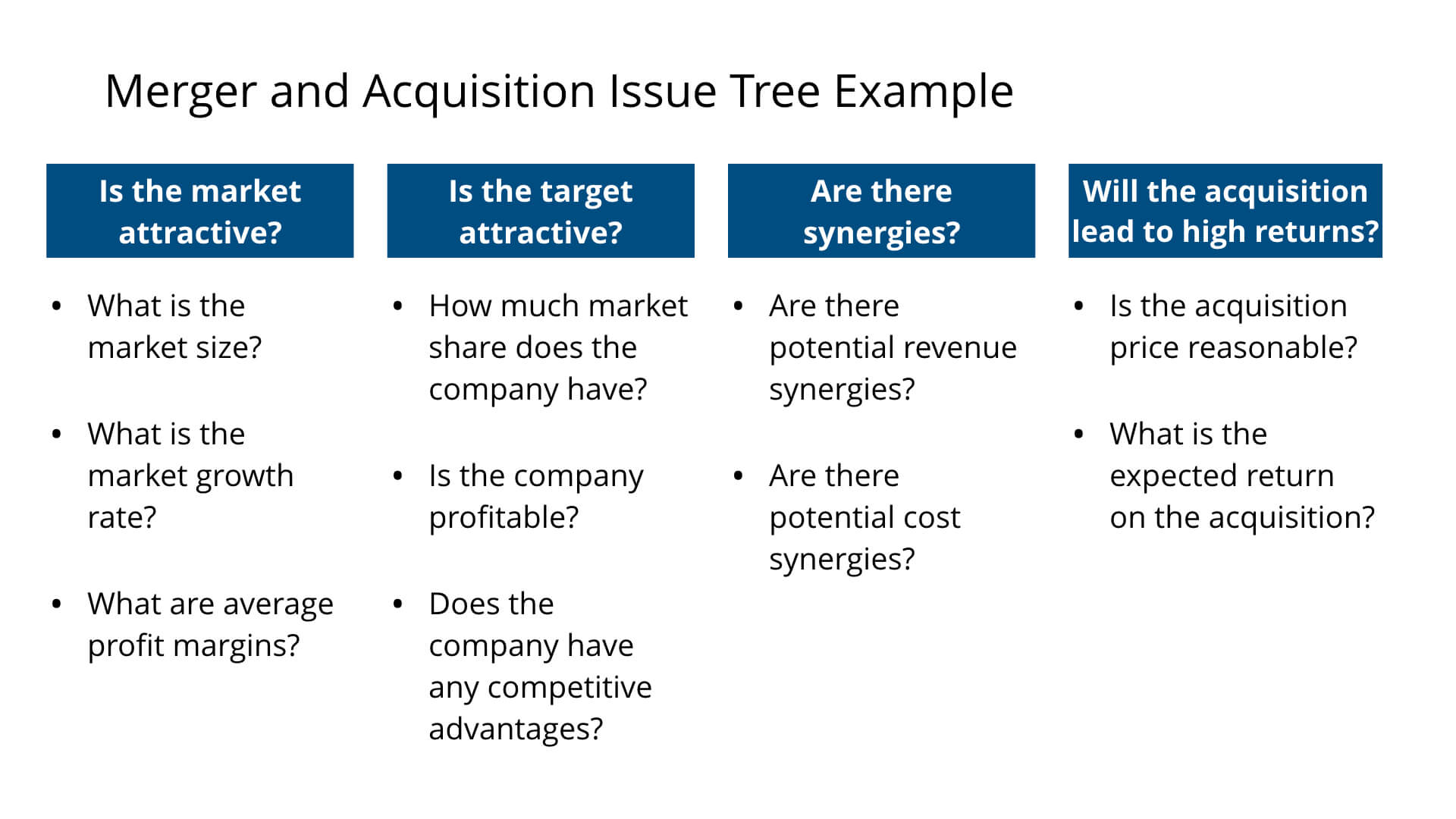
New Product Issue Tree Example
New product cases ask you to determine whether a company should launch a new product or service.
A potential issue tree template for this case could explore four major issues:
- Is the market attractive?
- Will customers like the product?
- Does the company have the capabilities to successfully launch the product?
- Will the company be profitable from launching the product?

Pricing Issue Tree Example
Pricing cases ask you to determine how to price a particular product or service.
A potential issue tree template for this case could explore three major issues:
- How should we price based on the product cost?
- How should we price based on competitors’ products?
- How should we price based on customer value?
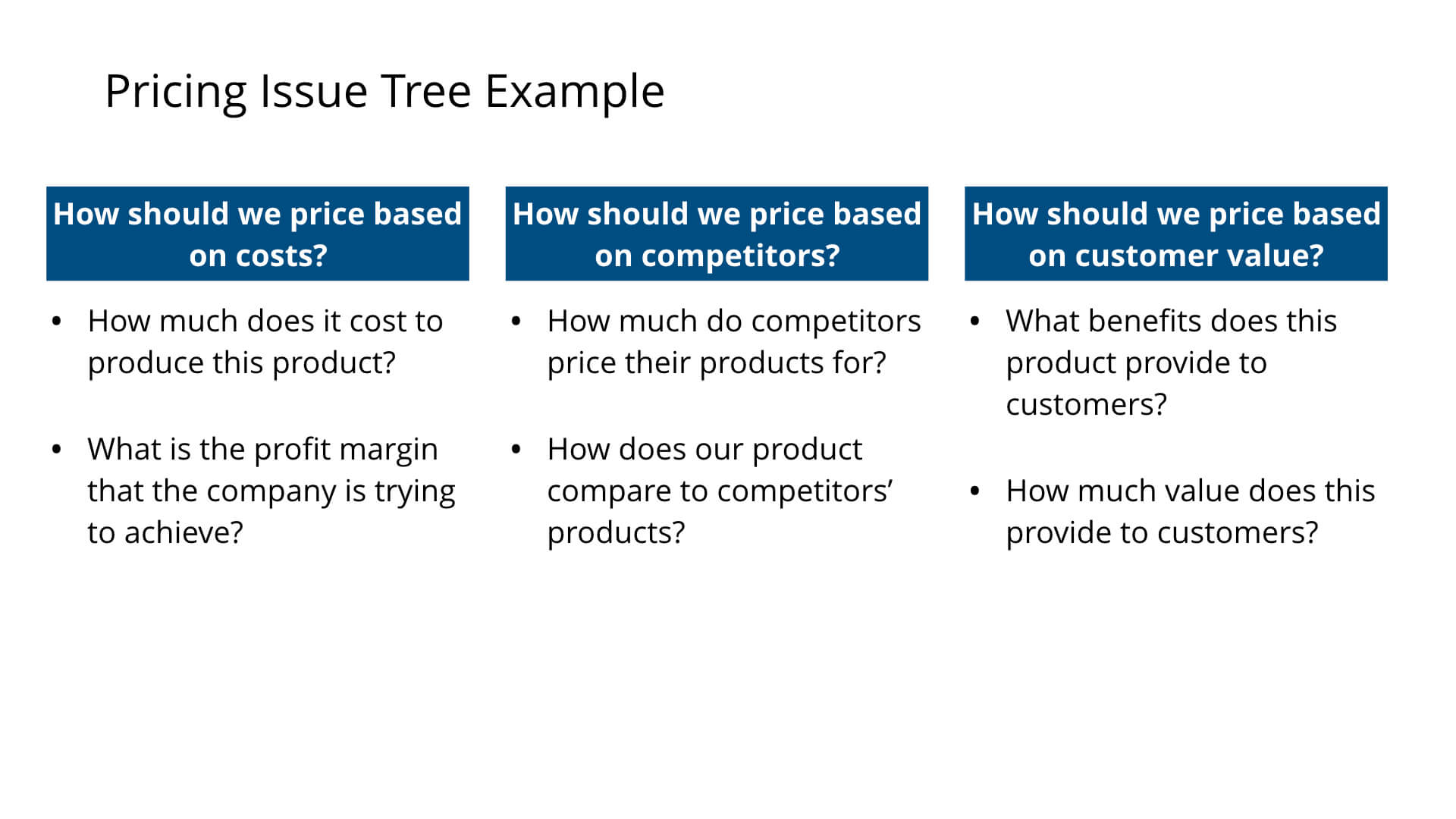
What are Tips for Making Effective Issue Trees?
Issue trees are powerful tools to solve complex business problems, but they are much less effective if they don’t follow these important tips.
Issue tree tip #1: Be MECE
MECE stands for mutually exclusive and collectively exhaustive. When breaking down the overall problem in your issue tree, the final list of smaller problems needs to be mutually exclusive and collectively exhaustive.
Mutually exclusive means that none of the smaller problems in your issue tree overlap with each other. This ensures that you are working efficiently since there will be no duplicated or repeated work.
For example, let’s say that two of the issues in your issue tree are:
- Determine how to increase cups of lemonade sold
- Determine how to partner with local organizations to sell lemonade
This is not mutually exclusive because determining how to partner with local organizations would include determining how to increase cups of lemonade sold.
In determining how to increase cups of lemonade sold, you may be duplicating work from determining how to partner with local organizations.
Collectively exhaustive means that the list of smaller problems in your issue tree account for all possible ideas and possibilities. This ensures that your issue tree is not missing any critical areas to explore.
For example, let’s say that you break down the issue of determining how to decrease variable costs into the following issues:
- How can we decrease costs of lemons?
- How can we decrease costs of water?
- How can we decrease costs of ice?
This is not collectively exhaustive because you are missing two key variable costs: sugar and cups. These could be important areas that could increase profitability, which are not captured by your issue tree.
You can read a full explanation of this in our article on the MECE principle.
Issue tree tip #2: Be 80/20
The 80/20 principle states that 80% of the results come from 20% of the effort or time invested.
In other words, it is a much more efficient use of time to spend a day solving 80% of a problem and then moving onto solving the next few problems than to spend five days solving 100% of one problem.
This same principle should be applied to your issue tree. You do not need to solve every single issue that you have identified. Instead, focus on solving the issues that have the greatest impact and require the least amount of work.
Let’s return to our lemonade stand example. If we are focusing on the issue of how to decrease costs, we can consider fixed costs and variable costs.
It may be a better use of time to focus on decreasing variable costs because they are generally easier to lower than fixed costs.
Fixed costs, such as paying for a business permit or purchasing a table and display sign, typically have long purchasing periods, making them more difficult to reduce in the short-term.
Issue tree tip #3: Have three to five branches
Your issue tree needs to be both comprehensive, but also clear and easy to follow. Therefore, your issue tree should have at least three branches to be able to cover enough breadth of the key issue.
Additionally, your issue tree should have no more than five branches. Any more than this will make your issue tree too complicated and difficult to follow. By having more than five branches, you also increase the likelihood that there will be redundancies or overlap among your branches, which is not ideal.
Having three to five branches helps achieve a balance between going deep into specific sub-issues and covering a broad range of aspects. It balances breadth and depth.
Issue tree tip #4: Clearly define the top-level issue
Make sure that you clearly articulate the main problem or question. This sets the foundation for the entire issue tree. If you are addressing the wrong problem or question, your entire issue tree will be useless to you.
Issue tree tip #5: Visualize the issue tree clearly
If you're using a visual representation, make sure it's easy to follow. Use clean lines, appropriate spacing, and clear connections between components.
Keep your issue tree organized and neat. A cluttered or disorganized tree can be confusing and difficult to follow.
Ensure that each branch and sub-issue is labeled clearly and concisely. Use language that is easily understandable to your audience.
Issue tree tip #6: Order your branches logically
Whenever possible, try to organize the branches in your issue tree logically.
For example, if the branches in your issue tree are segmented by time, arrange them as short-term, medium-term, and long-term. This is a logical order that is arranged by length of time.
It does not make sense to order the branches as long-term, short-term, and medium- term. This ordering is confusing and will make the entire issue tree harder to follow.
Issue tree tip #7: Branches should be parallel
The branches on your issue tree should all be on the same logical level.
For example, if you decide to segment the branches on your issue tree by geography, your branches could be: North America, South America, Europe, Asia, Africa, and Australia. This segmentation is logical because each segment is a continent.
It would not make sense to segment the branches on your issue as United States, South America, China, India, Australia, and rest of the world. This segmentation does not follow logical consistency because it mixes continents and countries.
Issue tree tip #8: Practice and get feedback
It takes practice to create comprehensive, clear, and concise issue trees. This is a skill that takes time to develop and refine.
When you initially create your first few issue trees, it may take you a long period of time and you may be missing key sub-issues. However, with enough practice, you’ll be able to create issue trees effortlessly and effectively.
Practice creating issue trees on different problems to improve your skills. Seek feedback from peers or mentors to refine your approach.
Author: Taylor Warfield
Proven Tools to Help You Land Your Consulting Offer
Landing a consulting offer isn’t easy — but with the right preparation, it’s absolutely achievable. Below are the top resources we recommend to help you master case interviews, crush behavioral and fit questions, and secure more interviews.
These are the same tools successful candidates have used to break into top consulting firms — and you can, too.
1. Case Interview Course (Our Top Pick)
Our #1 best-seller. Whether you have no business background, rusty math skills, or limited time, this step-by-step course will transform you into a top 1% candidate who lands multiple offers. Trusted by 5,000+ consulting candidates and rated 5/5.
“I landed my dream job in consulting and increased my salary by 50%. The M.D. who interviewed me later told me my case interview performance was the best he’d ever seen!” — Sheen C.
2. Fit Interview Course
Be prepared for 98% of consulting behavioral and fit questions in just a few hours. Learn exactly how to craft answers that impress interviewers. Rated 4.9/5 by past candidates.
3. Resume Review
Transform your resume into one that consistently lands interviews at top consulting firms such as McKinsey, BCG, and Bain. 100% satisfaction rate from past clients.
→ Get Your Resume Reviewed Now
4. Case Interview Coaching
Personalized, one-on-one coaching with me, Taylor Warfield — former Bain Manager and interviewer — to help you build confidence and master tough cases. 100% satisfaction rate from past clients.
5. Ultimate Consulting Offer Package
Everything you need to land your consulting offer. Includes resume review, cover letter review, all online courses, personalized case coaching, and fit interview coaching. Save 20% compared to purchasing separately.
Every day you wait is one less day to prepare. Invest in your future today and take the next step toward securing your consulting offer.
